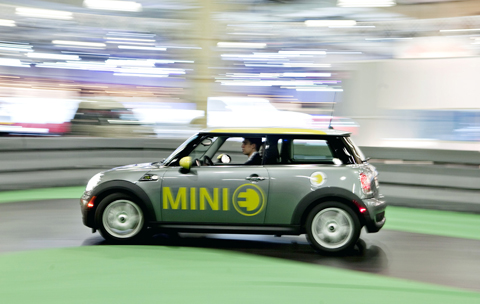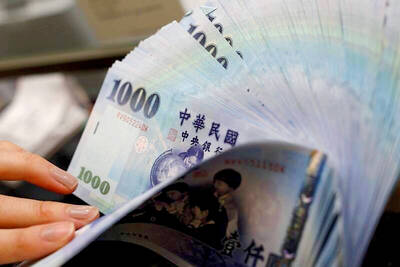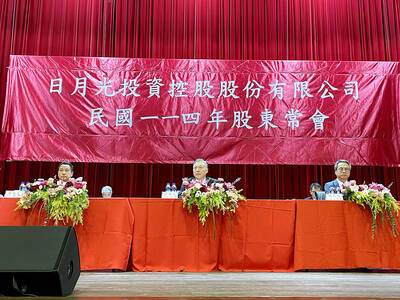Electric cars are selling well, as incentives and new models make them a realistic option, but the fresh attention may highlight flaws compared with gasoline and alternatives such as biofuels.
The attention rankles with some in the biofuel industry, whose own hype was abruptly halted by a glut of production in 2007, subsequent bankruptcies and a fall from grace after a link was drawn — which they dispute — between biofuels and spiraling food prices and rising hunger.
Gasoline may beat both alternatives for decades as the least-worst option, with wider adoption of more efficient conventional cars helping to curb carbon emissions and oil dependence.

PHOTO: BLOOMBERG
The uncertainty is striking for a US$5 trillion to US$6 trillion global auto and fuel supply market, where there is agreement only that the number of cars will keep rising, perhaps doubling to 2 billion by 2050.
The momentum is with electricity, following an oil price spike in 2008, lavish government incentives and a crippling downturn across the wider car industry. Last week the US finalized fuel efficiency standards, following similar rules in Europe.
Green cars grabbed center stage at auto shows this year in New York, Geneva and Detroit, including all-battery cars, hybrid varieties that switch between electric and gasoline, and small, more fuel-efficient conventional cars.
However, battery electric vehicles (EVs) are expensive.
Mitsubishi Motors and Nissan Motor Co last week announced prices for their i-MiEV and Leaf battery-only electric cars, in production already or about to debut, at ¥3.98 million (US$42,520) and ¥3.76 million respectively before state subsidies, several times the cost of equivalent cars.
Reality bites with driving ranges of about 160km, far less than for a petrol car, which US customers expect to exceed 500km.
And electric cars have to contend with the multibillion-dollar cost of a new charging infrastructure, although they benefit from running costs at about a quarter of gasoline at today’s prices, according to electric car advocates.
“The electric vehicle sector certainly has momentum, but it’s questionable whether it has the legs for the longer term, at least at the moment, and whether it has enough scale,” said Peter Wells at Cardiff University’s Centre for Automotive Industry Research, who expected big cost reductions.
Success depends on drivers accepting limitations on range and on re-charging time, which takes several hours, said Pierre Gaudillat, research and development manager at the UK-funded Carbon Trust.
“I don’t see any major breakthrough on the horizon,” he said.
Customers may have to compromise on what they expect from a car, perhaps tailored for commuting, and from ownership, for example buying the car but renting the expensive battery.
Hybrid gasoline-electric cars overcome the range problem but are still pricey because of their complexity and battery costs. Sales of hybrid-electric vehicles are expected to reach about 1.3 percent of an estimated 67 million light vehicle sales this year, according to the information company J.D. Power and Associates.
Battery-powered, all electric vehicles will only amount to about 20,000 units, but by 2015 could reach a 0.3 percent market share.
The International Energy Agency says electric vehicles and hybrids must reach at least 7 percent of global car sales by 2020 to hit targets to avoid more dangerous climate change.
Global biofuel production, meanwhile, will grow 16 percent next year, according to the Global Renewable Fuels Alliance.
Gasoline may continue to dominate both, especially if oil price rises are muted by efficiency drives. Automakers are already making smaller engines more powerful and transmissions more efficient, while the carbon emissions savings of both electric and biofuels are disputed.
“I think oil-based transport fuels have such a competitive advantage and dominance that you need a compelling argument to move to something different, and the case has not been made for what that is,” said Chris Mottershead, vice principal of research and innovation at King’s College London, and former head of climate change at oil major BP.
Technologies to replace gasoline enthuse investors, even those doubtful of any climate threat, given the vulnerability of the US and others to oil prices. The US imports over half the petroleum it consumes.
HSBC is one backer of electric, investing US$125 million in January in Better Place, a California-based company that wants to build charging networks and lease batteries to customers.
HSBC climate change analyst Nick Robins stressed a wider benefit, or “positive spill-over,” from electric cars which he contrasted with the negative wider impact of biofuels. Car batteries could help balance electric grids that are increasingly dependent on intermittent wind, by re-charging at night, Robins said.
Biofuels are made from sugar, corn and oil seeds now, and perhaps in the future from grass, crop waste and wood. Rising biofuel demand has stoked prices of feedstocks such as corn, but may only have played a small part in the 2008 food price spike, analysts say.
The oil major Royal Dutch Shell is a big backer of ethanol, striking a deal in February with Brazil’s Cosan to create a US$21 billion a year ethanol joint venture.
Ethanol made from Brazil’s sugar cane is economic at an oil price of US$40 to US$50 a barrel, compared with US$80 oil prices now. That has created an autos market in Brazil where most new cars are flex-fuel, handling any blend of gasoline and ethanol, at no extra cost.

Merida Industry Co (美利達) has seen signs of recovery in the US and European markets this year, as customers are gradually depleting their inventories, the bicycle maker told shareholders yesterday. Given robust growth in new orders at its Taiwanese factory, coupled with its subsidiaries’ improving performance, Merida said it remains confident about the bicycle market’s prospects and expects steady growth in its core business this year. CAUTION ON CHINA However, the company must handle the Chinese market with great caution, as sales of road bikes there have declined significantly, affecting its revenue and profitability, Merida said in a statement, adding that it would

RISING: Strong exports, and life insurance companies’ efforts to manage currency risks indicates the NT dollar would eventually pass the 29 level, an expert said The New Taiwan dollar yesterday rallied to its strongest in three years amid inflows to the nation’s stock market and broad-based weakness in the US dollar. Exporter sales of the US currency and a repatriation of funds from local asset managers also played a role, said two traders, who asked not to be identified as they were not authorized to speak publicly. State-owned banks were seen buying the greenback yesterday, but only at a moderate scale, the traders said. The local currency gained 0.77 percent, outperforming almost all of its Asian peers, to close at NT$29.165 per US dollar in Taipei trading yesterday. The

RECORD LOW: Global firms’ increased inventories, tariff disputes not yet impacting Taiwan and new graduates not yet entering the market contributed to the decrease Taiwan’s unemployment rate last month dropped to 3.3 percent, the lowest for the month in 25 years, as strong exports and resilient domestic demand boosted hiring across various sectors, the Directorate-General of Budget, Accounting and Statistics (DGBAS) said yesterday. After seasonal adjustments, the jobless rate eased to 3.34 percent, the best performance in 24 years, suggesting a stable labor market, although a mild increase is expected with the graduation season from this month through August, the statistics agency said. “Potential shocks from tariff disputes between the US and China have yet to affect Taiwan’s job market,” Census Department Deputy Director Tan Wen-ling

UNCERTAINTIES: The world’s biggest chip packager and tester is closely monitoring the US’ tariff policy before making any capacity adjustments, a company official said ASE Technology Holding Inc (日月光投控), the world’s biggest chip packager and tester, yesterday said it is cautiously evaluating new advanced packaging capacity expansion in the US in response to customers’ requests amid uncertainties about the US’ tariff policy. Compared with its semiconductor peers, ASE has been relatively prudent about building new capacity in the US. However, the company is adjusting its global manufacturing footprint expansion after US President Donald Trump announced “reciprocal” tariffs in April, and new import duties targeting semiconductors and other items that are vital to national security. ASE subsidiary Siliconware Precision Industries Co (SPIL, 矽品精密) is participating in Nvidia